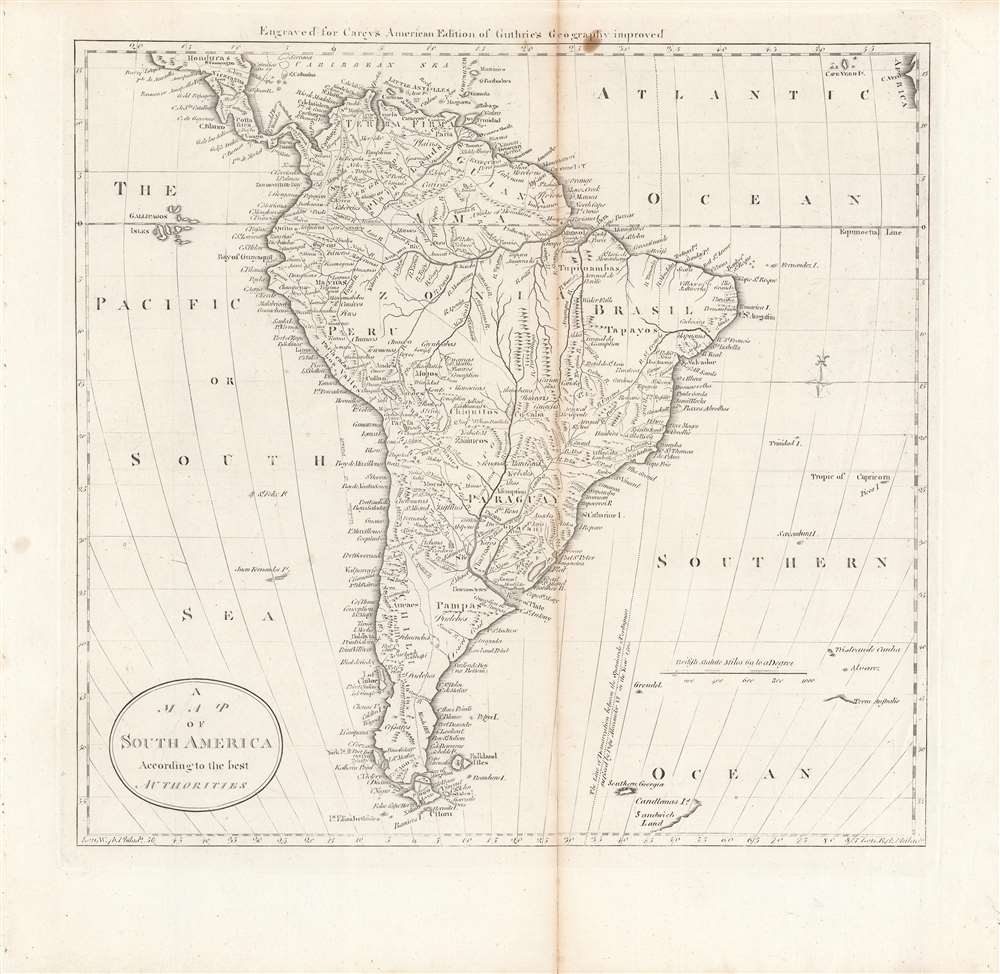1795 Carey Map of South America
SouthAmerica-carey-1795
Title
1795 (undated) 13 x 13.75 in (33.02 x 34.925 cm) 1 : 25344000
Description
A Closer Look
The map is exhaustive in the labelling of coastal settlements, mountains, rivers, lakes, islands, regions, and indigenous groups. The discoveries of Captain James Cook, such as South Georgia and the South Sandwich Islands, some twenty years before this map's publication, have been incorporated. However, Carey maintains a 'Terra Australis' in the South Atlantic, to the south of Gough Island (here as 'Alvarez').The coast of West Africa and the Cape Verde Islands appear at top-right, highlighting their proximity to Brazil. A scale is provided in British statute miles, while Philadelphia serves as Prime Meridian. A dotted line marks the division of Spanish and Portuguese spheres by Pope Alexander VI (and by the subsequent Treaty of Tordesillas between Spain and Portugal).
Independence for most of Spain's American colonies followed the American Revolution by several decades. Relations between the new governments were initially limited but expanded considerably by the mid-19th century. In 1811, President James Madison sent Joel Roberts Poinsett as an envoy and special agent to South America to report on and support independence movements there. Madison's successor, James Monroe, articulated the Monroe Doctrine in 1823, which has arguably remained the basis for U.S. relations with the continent ever since.
Publication History and Census
This map appeared in the 1795 or 1796 edition of Carey's General Atlas (often subtitled American Edition of Guthrie's Geography improved). The distribution of this map is difficult to firmly establish, due to uncertainty over its date and because OCLC catalog listings include digitized copies along with physical examples. In any event, both the individual map and the entire atlas are held by a handful of universities and research institutions in the United States and Europe, while the map is scarce to the market.CartographerS
Matthew Carey (January 28, 1760 - September 16, 1839) was a Dublin born publisher who established himself in Philadelphia in the late 18th and early 19th century. A young man of socially progressive views, Carey's first known publication, produced when he was but 17 years old, was a pamphlet criticizing dueling. Another pamphlet, issued in the same year, attacked the Irish penal code. Shortly afterwards, in 1779, legal issues, possibly arising from his liberal political activism, forced Carey to flee to Paris. In Paris, Carey had the good fortune to befriend the visiting American diplomat and founding father, Benjamin Franklin (1706 - 1790). As an Irishman chafing under the rule of England, Carey sympathized with and admired the American revolutionary. The liberally minded pair struck up a lifelong friendship and Carey was hired to work at Franklin's press in Passy, France. A year later, Carey returned to Ireland and resumed his politically provocative publishing career with The Freemans's Journal and The Volunteer's Journal. It didn't take long for political pressure to once again force Carey from Ireland - this time to America (1784). Although largely without funds, Carey convinced Gilbert du Motier, Marquis de Lafayette (1757 - 1834), who he knew from Franklin's Paris circle, to lend him funds to establish a new publishing concern in Philadelphia. Despite this loan, Carey's firm remained under financed and opened on a shoestring budget. It was most likely his limited budget that led Carey to some of his most important publishing innovations. At the time cartographic publishing was dominated by large printing houses in London and Paris where most, if not all, of the work was completed in house. Without the finances to emulate this large publishing houses, Carey was forced to outsource much of his publishing work. This set the stage for subsequent American publishers who, in order to compete effectively with European firms, relied on an often bewildering network of alliances and collaborations. Carey was also a master of republishing many of his own maps in multiple different atlases and formats to maximize their profitability. His most important work is without a doubt the 1795 issue of the American Atlas the first atlas to be published in America. Carey died in 1839 but was succeeded by his son Henry Charles Carey (1793 - 1879) who, in partnership with his brother-in-law Isaac Lea (1792 - 1886), published numerous important maps and atlases under the Carey and Lea, Lea Brothers, and Lea and Blanchard imprints. More by this mapmaker...
William Guthrie (1708 - March 9, 1770) was a Scottish historian, journalist, and writer. Born in Brechin, he studied at Aberdeen University with the idea of becoming a parochial schoolmaster. Instead, in 1730, he elected to settle in London and try his hand at literature. He covered parliamentary debates f or the Gentleman's Magazine and soon earned a reputation for being a political writer. He published several scholarly works, including a History of England from the Invasion of Julius Caesar to 1688 in four volumes, and, most notably, his Geographical Historical, and Commercial Grammar. Learn More...

